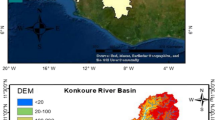Abstract
Land use has changed in the Daqinghe watershed during 1956–2005, and it has influenced the flood peak and volume. In order to reveal the effects of land use change on flood characteristics in Daqinghe watershed, we selected 2 sub-watersheds and used remote-sensed land use data of 1980 and 1996 to analyze changes in land use and also selected several combinations of similar rainfall events and the corresponding flood events to show how changes in land use affect floods. The forest and urban area increased and other types decreased, and flood peaks and volumes tended to decrease under similar rainfall events. To quantify the extent of change in land use affecting floods, a hydrological model incorporating the land use was established. The model combines infiltration excess and saturation excess runoff generation mechanism in each type of land use, and the simulation results agreed well with the measured flood processes in the two selected watersheds. Several floods of different return intervals were selected to be modeled under the 1980 and 1996 land use conditions. The results show that both flood peak and volume decreased under the 1996 land use condition in comparison with the 1980 land use condition in the two watersheds. Most of the flood peaks decreased <5 %, but the volume decreased to a greater extent. This result can be helpful in modifying design flood.






Similar content being viewed by others
References
Brath A, Montanari A, Moretti G (2004) Assessing the effect on flood frequency of land use change via hydrological simulation (with uncertainty). J Hydrol 324:141–153
Bronstert A, Bardossy A, Bismuth C et al (2007) Multi-scale modelling of land-use change and river training effects on floods in the Rhine basin. River Res Appl 23:1102–1125
Chang H, Franczyk J (2008) Climate change, land-use change, and floods: toward an integrated assessment. Geogr Compass 2:1549–1579
Costa MH, Botta A, Cardille JA (2003) Effects of large-scale changes in land cover on the discharge of the Tocantins River, Southeastern Amazonia. J Hydrol 283:206–217
Farazjoo BSH, Yazdandoost BBF (2008) Flood intensification due to changes in land use. Water Resour Manag 22:1051–1067
Lorup JK, Refsgaard JC, Mazvimavi D (1998) Assessing the effect of land use change on catchment runoff by combined use of statistical tests and hydrological modelling: case studied from Zimbabwe. J Hydrol 205:147–163
Miller SN, Kepner WG, Mehaffey MH et al (2002) Integrating landscape assessment and hydrological modelling for land cover change analysis. J Am Water Resour As 38:915–929
Naef F, Scherrer S, Weiler M (2002) A process based assessment of the potential to reduce flood runoff by land use change. J Hydrol 267:74–79
Niehoff D, Fritsch U, Bronstert A (2002) Land-use impacts on storm-runoff generation: scenarios of land use change and simulation of hydrological response in a meso-scale catchment in SW-Germany. J Hydrol 267:80–93
Ott B, Uhlenbrook S (2004) Quantifying the impact of land-use changes at the event and seasonal time scale using a process-oriented catchment model. Hydrol Earth Syst Sci 8:62–78
Post DA (1996) Identification of relationships between catchment-scale hydrologic response and landscape attributes, Ph.D. Thesis. Australian National University, Australian
Wongsa S, Shimizu Y (2004) Modelling artificial channel and land-use changes and their impact on floods and sediment yield to the Ishikari basin. Hydrol Process 18:1837–1852
Xie P, Zhu Y, Chen G et al (2007) A lumped watershed hydrological model considering land use and land cover change and its application. J Mt Sci 25(3):257–264
Xu X (2007) Research on the trends of runoff generation and convergence characteristics of Panjiakou reservoir basin, M. S. Thesis, Tianjin University, pp 78
Zhao RJ (1984) Hydrological simulation of watershed–Xin’anjiang model and Shanbei model. Water Conservancy and Electric Power Press, China
Acknowledgments
This work was supported by State Key Laboratory of Hydrology-Water Resources and Hydraulic Engineering, Hohai University (No. 2011490611) and also by National Natural Science Foundation of China (No. 51209157). We are also grateful to Hydrology and Water Resource Survey Bureau of Hebei Province for providing the hydrological data.
Author information
Authors and Affiliations
Corresponding author
Rights and permissions
About this article
Cite this article
Li, J., Feng, P. & Chen, F. Effects of land use change on flood characteristics in mountainous area of Daqinghe watershed, China. Nat Hazards 70, 593–607 (2014). https://doi.org/10.1007/s11069-013-0830-8
Received:
Accepted:
Published:
Issue Date:
DOI: https://doi.org/10.1007/s11069-013-0830-8




